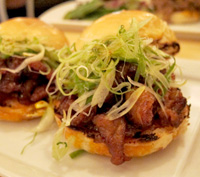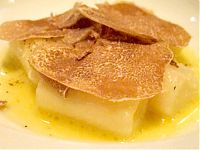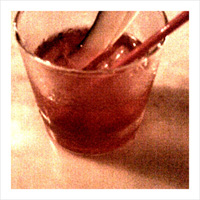Moqueca
by Sonya Collins
July 29, 2008
My all-time favorite Brazilian dish, a hearty, coconut milk-based seafood stew from the state of Bahia, is moqueca baiana. A perfect marriage of indigenous, Portuguese and African traditions in the Brazilian kitchen, it represents the elements that lie at the very heart of Brazilian culture. Moqueca (moh-KEH-kah) is also an example of Brazilians’ passionate debate over what’s authentic Brazilian cuisine. In sampling any of the variations of this dish, one tastes the differences among the diverse palates in this enormous country.
I live in the south of Brazil, thousands of miles from the northeastern state of Bahia. But Florianópolis is also an island where all seafood dishes are popular, so moqueca is easy to find. Still, to make sure I got a “real” moqueca (in my opinion), I sought to fulfill my craving at an authentic Bahian restaurant.

At Cida Baiana, a restaurant specializing in northeastern Brazilian cuisine, located in the hip neighborhood of Lagoa, everything was as I expected: rustic wooden furnishings, Afro-Brazilian art, and dinner served in traditional clay pots. But one thing was missing: the strong aroma of dendê (den-DAY), a thick, pulpy golden palm oil extracted from African palms that also grow in the state of Bahia. When I didn’t smell it as soon as I walked in the door, I feared that this Bahian restaurant had adapted its recipes to cater to the blander southern Brazilian palate. Still, I held onto hope until the waiter came through the swinging doors of the kitchen, moqueca in hand. My dinner, however, was unaccompanied by that sharp, pungent aroma I had been longing for. What I ate instead was a delicious — albeit light and mild — fish stew, full of chunks of white fish, shrimp, and mussels. It was far too light on the dendê for my craving. While I was disappointed, the clientele at Cida Baiana probably never complain: for each person who loves dendê, there’s another who can’t stand even the smell of it.
In fact, from one region to the next, it’s impossible to find a consensus on what constitutes authentic moqueca. Residents of the central coastal state Espírito Santo hold that moqueca capixaba (ka-pee-SHA-ba) is the only moqueca. A Google search of the word “moqueca” brings up a funny post that reads (in Portuguese), “Forgive me, Dictionary, but moqueca capixaba is the only moqueca, and anything else is just fish stew.” Brazilians from the African-influenced northeast, however, will make the same claim about moqueca baiana (buy-AH-nah). The use of coconut milk and dendê distinguishes it from moqueca capixaba. And these ingredients, in my opinion, are what give the dish its distinctive (and divine) flavor. Like dendê, northeastern cuisine is known for its pungent, robust and spicy flavors, while southern cuisine tends towards milder seasonings, no bolder than onions, garlic and olive oil. The northeastern version of moqueca, incidentally, is the type most often found in New York, where I got hooked on the stuff.
While the Portuguese originally introduced the concept of fish stew to Brazil, it was the indigenous people who adapted the way the fish was prepared. The name moqueca refers to the moquém, a grill of sticks or leaves and smoldering ashes, on which the native people cooked the fish, though this grill is no longer used for the dish today. African slaves in the northeast, a slave-trafficking hub, cooking for Portuguese masters, further adapted the recipe, replacing the grill with a large mud pot. They simmered the fish in coconut milk with dendê — the way it is still prepared today — so that the fish slowly absorbs the flavors of the other ingredients — sliced tomatoes, red, yellow, and green peppers, and cilantro.
Traditional side dishes that accompany moqueca are rice and pirão (peer-OW), a thick, glutinous fish-and-tomato sauce made from a chunky purée of the unused parts of the fish — the head, tail, and fins. Seasoned with garlic and olive oil, pirão can be eaten over rice or by itself. Originally from the Portuguese-settled Azorean islands in the mid-Atlantic, pirão in Brazil contains manioc flour, added by the indigenous people; and often spicy malagueta peppers, an adaptation made once African slaves were in the Brazilian kitchen.
If you want to try moqueca baiana yourself, with plenty of dendê and coconut milk, the best one in New York is at Casa in the West Village, where it’s served home style in the traditional, rustic clay pots, and in a warm, cozy environment. At Circus, you can also get a great moqueca with an upscale Manhattan twist: instead of a stew, it’s jumbo shrimp drizzled with a sauce of dendê and coconut milk, and arranged in a circle around a mound of white rice. SushiSamba and The Coffee Shop, both in the Union Square area, also serve up worthwhile renditions of the dish.
The moqueca at Cida Baiana wasn’t what I had hoped for, but one thing went just as expected. The meal inspired a lively debate among my dining companions as to whether what we had just eaten was indeed authentic moqueca. Luciane says, “no,” but adds that it was just as well since she, sigh, doesn’t “like dendê that much anyway.” Carlos thought the meal was great, and Cassiano, just to be contrary, said, “Don’t ask me. I don’t even like fish.” As for me, I’m still searching for the perfect moqueca on my island in the south of Brazil. Until then, I know I could head north and find it in Bahia, or even further north on that other island, Manhattan.
CASA
72 Bedford St
@ Commerce St
New York, NY 10014
212-366-9410
map
CIRCUS
132 E 61st St
(Park & Lexington Ave)
New York, NY 10021
212-223-2566
map
SUSHISAMBA
245 Park Ave S
@20th St
New York, NY 10003
212-475-9377
map
THE COFFEE SHOP
29 Union Sq W
@ 16th St
New York, NY 10003
212-243-7969
map
Credits:
Photographs of moqueca and clay cups by Luciane Stocco.
Leo Legaspi
Aug 7, 11:10 AM
love your blog! i visited rio a couple of years back and had some moqueca. where would you go in nyc for some reasonably authentic brazilian fare?
Aug 7, 07:20 PM
I agree with Sonya that Casa’s got both great charm and delicious Brazilian cuisine.




















Comments (2)